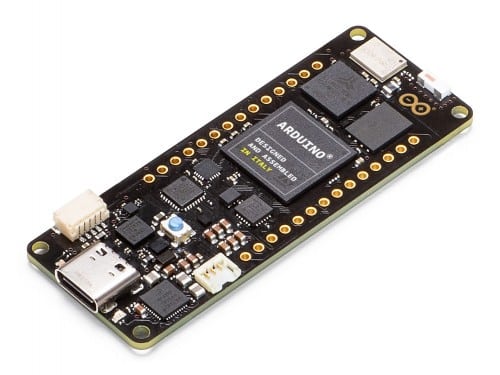The latest release by Arduino, that has a dual-core processor, low supply voltage, powerful graphics and connectivity, assures wide-ranging applicability in the field of AI and edge computing as well.

Arduino products are known worldwide to be one of the best in producing open-source hardware and software tools. Thanks to these products’ easy affordability, many people with minimal or nearly no electronics background have benefitted in creating their own IoT-based technological solutions. And now, the company has decided to step into the world of IIoT (Industrial Internet of Things).
In this regard, at the recently concluded CES 2020 held in Las Vegas, the U.S., Arduino launched the Portenta H7, its first-ever, low-power industrial board. Besides high-end industrial applications such as PLCs, the board is suitable for robotics, computer vision and other mission-critical applications as well.
This means companies and individuals can now quickly build their IoT applications (with respect to a wide temperature range of -40 degree Celsius to +85 degree Celsius) using a low-code application development platform with modular hardware, instead of relying on expensive consultants or lengthy integration projects that can take a lot of time to be executed.
“By combining the power and flexibility of our production-ready IoT hardware with our secure, scalable and easy to integrate cloud services, we are putting in the hands of our customers something really disruptive,” commented Arduino CEO Fabio Violante. “Among the millions of Arduino customers, we’ve even seen numerous businesses transform from traditional ‘one-off’ selling to subscription-based service models, creating new IoT-based revenue streams with Arduino as the enabler. The availability of a huge community of developers with Arduino skills is also an important plus.”
Dual-core processing
The Portenta H7 has two cores: Cortex M7 running at 480 MHz and Cortex M4 running at 240 MHz. Together, these constitute H7’s main processor, the dual-core STM32H747. This design enables the board to seamlessly run high-level code and tasks parallelly in real-time via a Remote Procedure Call mechanism. For example, it is possible to execute Arduino compiled code along with MicroPython one and at the same time, have both cores communicate with each other.
In addition to MicroPython, the H7 can also process applications created with TensorFlow Lite and JavaScript.
Expandable memory
Portenta H7 has an 8MB of SDRAM and 16MB of NOR Flash, which can be expanded up to 64MB of SDRAM and 128MB of NAND Flash. With respect to graphics accelerator, the board’s STM32H747 on-chip GPU called the Chrom-ART Accelerator, allows the possibility of building your own dedicated embedded computer with an exciting user interface. The on-chip also includes a dedicated JPEG encoder and decoder.
On-board connectivity
The on-board wireless module simultaneously manages WiFi and Bluetooth connectivity. The WiFi interface can handle 65Mbps transfer rate and can operate as an access point, as a station or as a combination of both (dual-mode AP/STA). Bluetooth interface supports Bluetooth Classic and BLE.
The board uses USB-C port as a programming connector. It can also be used to power the board, connect a DisplayPort monitor or deliver power to OTG connected devices.
With two 80 pin high-density connectors, required power supply of just 5V, extensive temperature range and a great set of hardware specifications, this latest generation of Arduino solution ensures simplicity and scalability for developing a vast range of innovations.







